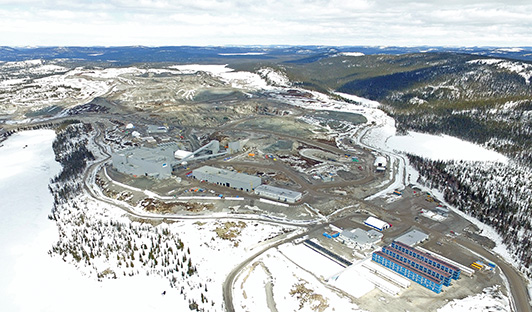Industry

New Mines Face Challenging Start
Prospects for the Gahcho Kué and Renard mines in Canada have improved as the rough market remains buoyant despite the quieter polished season.
By Avi Krawitz
 | | Renard mine |
It is said that when opening a business, timing is everything. For mining executives ready to launch a diamond mine, short-term market fluctuations can subdue the excitement of finally reaching commercial production and sales. Therefore, when Stornoway Diamond Corporation and Mountain Province Diamonds in May reported that average prices from their respective new mines in Canada during the first quarter were below expectations, they recognized the unfortunate circumstances surrounding their inaugural sales. “The company’s first diamond sales took place in the midst of a perfect storm for a first-time seller,” said Patrick Evans, president and CEO of Mountain Province, which owns a 49 percent stake in the De Beers–operated Gahcho Kué mine. Among those challenges, Evans explained, is that all new producers go through a period of price discovery, and that it takes about six months for production to be sold into the polished market before the true value of the mine’s output can be assessed. Beyond the technical challenges of starting a new mine, sales were also affected by volatility in the diamond market. Specifically, India’s demonetization program caused severe liquidity shortages in the country’s influential cutting and polishing segment, impacting Mountain Province’s first-quarter performance, Evans reported. In addition, he claimed that record sales at De Beers and ALROSA during the quarter also made it challenging for a first-time seller with a new product to compete with their more established supply. Stornoway, owner of the Renard mine, withheld goods from its first sale in November due to the impact of demonetization, which was announced the week prior to its inaugural tender. However, president and CEO Matt Manson dismissed that strong sales at the two major suppliers affected Stornoway’s sales performance. If anything, participation in the company’s tenders increased throughout the first quarter as Indian liquidity returned, he stressed.
YOU MUST HAVE JAVASCRIPT ENABLED TO VIEW THE SLIDESHOW
De Beers sold $520 million worth of rough in May, meaning the company’s sales over the first four sights of the year fell 3 percent year on year to $2.39 billion — even as sales volume increased 74 percent in the first quarter. After rough prices dropped approximately 15 percent from the second half of 2015 to a year later, prices have since rebounded, rising by an estimated 4 percent so far this year (see Rapaport Rough Prices Index chart in slideshow). Sightholders noted that manufacturing profit margins tightened in the past month as polished prices remained stagnant. “The increase in rough prices, without a commensurate strengthening of polished prices, has had a detrimental effect on midstream profit,” one sightholder said on condition of anonymity. The RapNet Diamond Index (RAPI™) for 1-carat diamonds slid .2 percent from May 1 to 22. RAPI for .30-carat diamonds edged up .1 percent, while RAPI for .50-carat fell 1 percent. The index for 3-carat diamonds rose .4 percent during the period (see Rapaport Diamond Index [RAPI™] chart in slideshow). Polished trading was sluggish during May as dealers were waiting for the shows in Las Vegas, which took place after press time, to assess the pulse of the market. Suppliers were holding prices firm for new polished production they hoped to sell in Las Vegas, but were willing to reduce prices on leftover old stock. Bruce Cleaver, De Beers CEO, observed there continues to be steady demand for rough, despite the industry entering a typically quieter season. That has some manufacturers worried their profit margins may come under further pressure. Mining companies remain confident the market will absorb the additional rough coming in from new sources like Mountain Province and Stornoway — without impacting liquidity or prices, Manson stressed. If anything, the Renard mine — and Gahcho Kué — may be coming on stream at an opportune time, he added. “As miners, we cannot look at the short-term market fluctuations as we develop a new mine. It’s a long-term investment,” Manson said. “We do consider that right now we’re at the top of the supply curve as we expect global production to decline from around 2019 onward.”
Article from the Rapaport Magazine - June 2017. To subscribe click here.
|
|